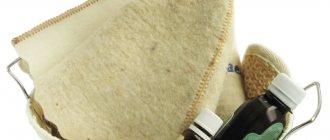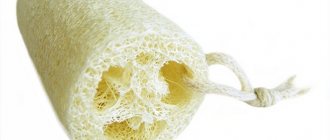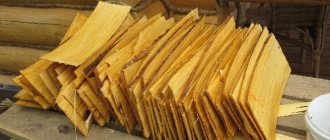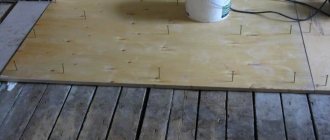A washcloth is one of the main attributes of facial and body hygiene. Such a familiar and easy-to-use item performs several tasks at once. A properly selected washcloth will become a massager, replace a scrub, and get rid of ingrown hairs and cellulite. Over the past couple of years, the demand for natural washcloths has increased significantly. People increasingly prefer products made from natural materials, especially when it comes to hygiene and body care. There is plenty to choose from: today there are more than ten types of so-called eco-scrubbers. I use these myself and today I’ll tell you about them in more detail.
Washcloth "Mitten" made of jute, crocheted
Master class from Natalia “ECO Gift with Pilling Effect”
If the video materials were not enough, read on for a brief description of how to make a washcloth-mitten for the shower.
To make a washcloth you will need office jute and a hook.
Stationery jute weighing 1.5 kg (to be absolutely precise - 1569 grams)
In general, you can find any crochet pattern you want to try. The only thing is that the pattern should be semicircular on one side of the mitten, and straight on the other.
Ready “front” side and “back”.
Here is the result - the “face” and “back” are connected, a loop is attached for hanging on a hook. The finished washcloth-mitten is slightly larger than the palm of your hand so that you can put it on your hand:
One washcloth takes about 75 grams of thread and approximately 3 hours of time, if you take your time, periodically glancing with one eye at the computer screen with a movie and sipping tea.
Next, wash the washcloth, dry it and steam it with an iron, so it will become more pleasant to the touch.
Product comparison table
| Model | Dimensions | Hardness degree | Foaming |
| Butterfly, viscose mitten | 20x13 cm | Small and medium | Bad |
| PROFFI PS0363 sisal | 45x10 cm | Average | good |
| Art de lis, nettle | 46x10 cm | Average | Bad |
| Eva, linen | 45x10 cm | Small | Bad |
| Fine Silk sea sponge | 1.5-2 and 3-5 inches | Small | good |
| Spivak, dry massage brush | 38x7 cm | High | good |
| "Cranky" | 20x16x1 cm | High | good |
| Arix with massage effect | 15x12x17 cm | Small | good |
| Tiande, towel | 30x100 cm | Average | good |
The simplest round sponge for washing dishes made of jute
Jute thread is very stiff, so it is better to use a large metal hook. For one sponge you will need a small skein of jute thread (costs from 70 rubles per 100 meters, sold in craft stores), a hook (preferably thick and metal, since loose knitting is needed), scissors.
A round sponge is quite easy to make if you already have at least minimal crochet skills (remember your school craft lessons). You need to cast on five air loops, then loop. Next, knit in a circle, not forgetting about double crochets and adding the number of air loops at your discretion. Do not knit tightly, but pull out the loops, since the sponge should have gaps so that it dries well after use. You can knit some kind of pattern - it depends on your imagination. The round piece should be slightly larger than your palm in size, since then the sponge will “sit” in the water. You need to knit two identical ones, and then fasten them together with the same jute, leaving a small hole for the soap. The ends of the threads can be cut off, hidden, or made into a loop - you can hang a sponge on it next to the sink.
Such a sponge can completely decompose in 3 months, compared to the usual hundreds of years of decomposition of an ordinary commercial washcloth. You can imagine how many of our washcloths are already in landfills, especially if we changed them often, as recommended by all hygiene standards..
Compared to a regular sponge, a jute sponge wins on at least two points: firstly, it completely decomposes in three months (to do this, after cleaning, just put it on the bottom of a flower pot - this will also serve as drainage for the plant), and not in 200 years, and will also last in the kitchen not for a week or two, but up to a year or even longer. When using, it is important to remember that the sponge must be rinsed and dried thoroughly. It is also recommended to pour boiling water over it once a week to disinfect it. If at some point the sponge stretches and loses its aesthetic appearance, you can soak it in a soda solution and it will come off.
Sisal
The natural material is fiber from the leaves of the agave plant. Sisal is mined in Brazil and Mexico. Ropes are woven from coarse, densely twisted fiber, and thin threads are used to make washcloths.
The popular bookmaker has released a mobile application for Android, you can follow the link absolutely free.
Sisal accessories are the toughest washcloths, so you need to choose them wisely. In order not to rip off the delicate skin, it is better to use coarse washcloths. The face is not washed with sisal washcloths; the skin of the heels and feet needs rough cleaning. The accessory will remove steamed corns and calluses well.
Expert opinion
Evgenia Katyshkina
Household and farm management specialist
Sisal washcloths should be regularly treated with antimicrobial compounds and dried well. With proper use, it is suitable for use for six months.
How to make a jute washcloth softer?
For me, a person of the principle “what I see, I sing,” words are very important! And the description of the product is exactly the same. My every word, spoken or written, is confirmed by action. And, if I wrote that my jute washcloth is “processed and ready for use, you just need to remove the packaging,” then this means that the washcloth is really processed with the frenzy of a terry perfectionist and is safe to use even internally (but it’s better not to, because it doesn’t tasty). And so I decided to show you the process of this most thorough processing:
2 photos - freshly knitted washcloths, hard, prickly, completely unsuitable for use (in my opinion)
3 photos - I soak and wash the washcloths by hand in a mixture of rather aggressive detergents (I prefer more or less natural ones). The water after this process is like that swamp slurry
4 photos - thorough rinsing. The water is already cleaner, but not quite yet
5 photos - washing washcloths with handmade soap and coconut oil. I wash, scrub, and rinse each washcloth separately.
6 photos - I steam it in very, very hot water (almost boiling water) for 20-30 minutes. Then I rinse it one last time.
7 photos - washcloths are dried in the sun in summer, in the cold in winter
8 photos - already pleasant to the touch, clean, fragrant washcloths are being preened - I sew on tags, loops, pack them, seal them in bags with instructions.
And now, in full bloom and in the best possible shape, the washcloths go on sale. By the way, the photo shows very clearly how the structure of the jute thread changes. Remember this difference well! This will help you distinguish between a treated and safe loofah and a dishonest and unkempt one.
Birch bark
Natural washcloths, which are used very rarely today. Birch bark is a moisture-resistant material of high strength. Birch bark has antiseptic properties, so such washcloths should definitely be in a house where there are small children, people with allergies, and elderly family members.
Initially, the washcloth will be hard; over time, the fiber will soften, but it will not lose its ability to clean pores well.
Photos of beautiful jute washcloths for dishes, for the body and more
Natural bristles
Pig bristles or horsehair are popular materials for making washcloths. Products made from horsehair are more expensive, but short bristles last longer and clean rough areas of the skin better.
There are two types of brushes:
- the bristles are sewn onto the base, letting the ends out, you get a regular brush with a handle;
- Horse hair is woven into ropes, which are then tied into a washcloth in the form of a cloth, mittens, etc.
Both types of products cope well with cellulite and fluid stagnation in the muscles. Natural hair and stubble are not afraid of abrasives, so they can be used together with scrubs and anti-cellulite creams, during dry massage.
What natural products can replace washing powder?
Where to put old tights
Now you don’t have to throw away old tights: torn tights have been in fashion for many seasons now. Therefore, if your tights have developed a wrinkle, make bigger holes and continue wearing them! In the end, this is how you express your attitude towards the problem of tights accumulating in landfills.
Saint Laurent Fall-Winter 2015-2016: torn tights
If we still collect waste paper, plastic and metal sometimes somewhere, we haven’t thought of collecting old tights yet. As a result, many people accumulate them at home and lie like dead weight. Some people bring them to their dacha to store crops in them, some use them for tying trees, others use old tights as insulation. In general, everyone solves the problem of disposing of old tights on their own.
About 720 million pairs of tights and stockings are sold in Russia annually. This is approximately 34.5 tons. The decomposition period of polyamide under normal conditions is several hundred years.
Some countries have already become concerned about the problem of “nylon” waste: recycling programs for women’s tights have been developed. Old tights are being collected and citizens are encouraged not to throw out worn-out items in landfills, but rather to collect them and take them to recycling sites. Various useful products are made from tights: pack benches, ropes, coverings for outdoor playgrounds and much more. After all, nylon does not decompose for a very long time, and tights thrown into a household waste dump will accumulate there in an incorruptible form for a very long time.
A little history and purpose
It is not known for certain when the first devices appeared to help cleanse the skin, but already in references in Babylon and Ancient Greece there is information about the first washcloths. Wealthy people used wood or bronze to wash their skin, while poor people used bunches of plants or sand.
Now, a washcloth is already an absolutely necessary household item for every person. Beautifully designed, of different sizes, colors and purposes, they decorate the bathroom and are indispensable assistants in the bathroom.
A washcloth can be made from any available material: natural cotton or chintz, using old terry towels, woven from burlap, and for those who are not looking for easy ways - knitted.











